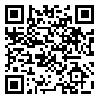Volume 75, Issue 8 (November 2017)
Tehran Univ Med J 2017, 75(8): 616-620 |
Back to browse issues page
1- Department of Forensic Medicine, Iran University of Medical Sciences, Tehran, Iran.
2- Department of Forensic Medicine, Iran University of Medical Sciences, Tehran, Iran. ,m59_ameri@ yahoo.com
2- Department of Forensic Medicine, Iran University of Medical Sciences, Tehran, Iran. ,
Abstract: (3760 Views)
Background: Sex determination from human remains is a challenge for forensic experts. Many studies have shown that the finger length ratios might be characteristic for sexual dimorphism. The aim of this study was to determine sexual dimorphism in finger length ratios among Iranian population.
Methods: The study group comprised of a random sample of 100 healthy people without congenital or acquired skeletal malformation or other obvious diagnosed disease, with the age range from 19 to 35 years in Tehran and Kashan cities, Iran, from March to the end of August of 2017. The number of male and female samples were equal. The lengths of second (2D), third (3D), forth (4D) and fifth (5D) finger of both hands were measured from the basal crease of the finger proximal to the palm to the tip of the finger using a ruler with a precision of 0.01 millimeters. Exploratory analysis were performed. Different finger ratios including 2D:3D, 2D:4D, 2D:5D, 3D:4D, 3D:5D and 4D:5D were calculated.
Results: The mean ratio of right fingers R 2:3, 2:4, 2:5, 3:4, 3:5, 4:5 and mean ratio of left fingers L 2:3, 2:4, 2:5, 3:4, 3:5, 4:5 were not equal in the groups compared. The index and ring finger ratio is found to be higher in males than females. Ratios of L 2:4, 3:4 and R 2:3, 2:4, 2:5 showed higher values in males.
Conclusion: Our results suggest that the 2D:4D ratio is the most decisive ratio which can demarcate between male and female in Iranian population. It may prove useful to determine the sex of an isolated hand in medicolegal examinations.
Methods: The study group comprised of a random sample of 100 healthy people without congenital or acquired skeletal malformation or other obvious diagnosed disease, with the age range from 19 to 35 years in Tehran and Kashan cities, Iran, from March to the end of August of 2017. The number of male and female samples were equal. The lengths of second (2D), third (3D), forth (4D) and fifth (5D) finger of both hands were measured from the basal crease of the finger proximal to the palm to the tip of the finger using a ruler with a precision of 0.01 millimeters. Exploratory analysis were performed. Different finger ratios including 2D:3D, 2D:4D, 2D:5D, 3D:4D, 3D:5D and 4D:5D were calculated.
Results: The mean ratio of right fingers R 2:3, 2:4, 2:5, 3:4, 3:5, 4:5 and mean ratio of left fingers L 2:3, 2:4, 2:5, 3:4, 3:5, 4:5 were not equal in the groups compared. The index and ring finger ratio is found to be higher in males than females. Ratios of L 2:4, 3:4 and R 2:3, 2:4, 2:5 showed higher values in males.
Conclusion: Our results suggest that the 2D:4D ratio is the most decisive ratio which can demarcate between male and female in Iranian population. It may prove useful to determine the sex of an isolated hand in medicolegal examinations.
Type of Study: Brief Report |
| Rights and permissions | |
 |
This work is licensed under a Creative Commons Attribution-NonCommercial 4.0 International License. |


